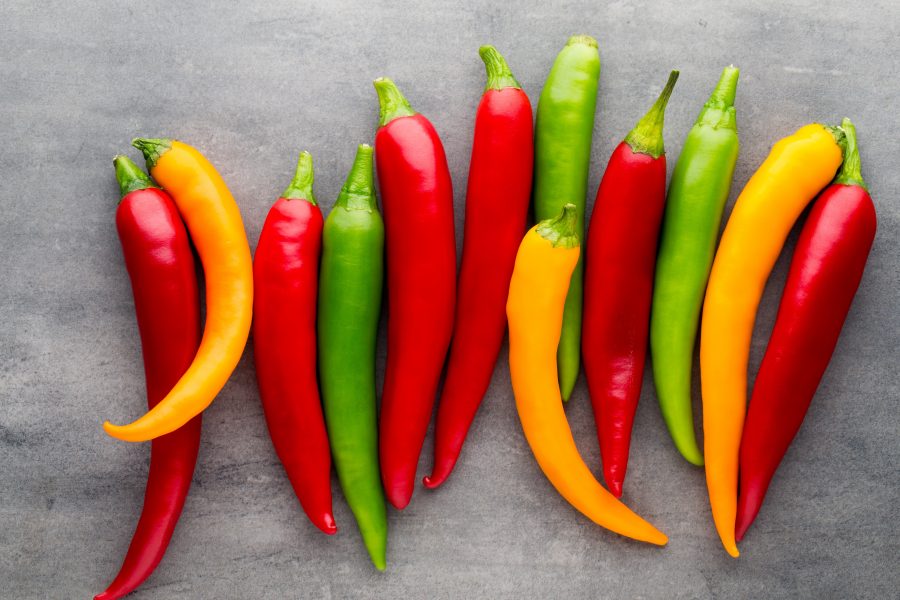The Country Smallholder explores the delights of the Chilli pepper, with tips for growing and varieties to try.
Chilli peppers are most probably the most exciting and colourful productive plants you could possibly grow. They may be sold as young plants for the home gardener to grow on, or as mature plants adorned with fruit as instant patio plants – ideal for near the barbecue. The fruits themselves may be sold fresh or dried, or made into a range of preserves.
History Of The Chilli
Chillies are native to South America where people have been cultivating and trading them for at least 6,000 years. Micro fossils of the starch grains found in chillies on grinding stones and cooking pots have been unearthed in the Caribbean, Venezuela and the Andes showing that domestic chillies were being eaten in southern Ecuador some 6,250 years ago. Because there are no wild chillies in southern Ecuador, domesticated plants must have been brought there from elsewhere, perhaps from Peru or Bolivia where it is though that they originated and where the greatest number of wild species are still found.
In 1492, when Christopher Columbus set off from Spain to find a westward route to Asia, he was keen to find new fruits and vegetables to bring back to Europe. Amongst his introductions were Maize, Tomatoes and Potatoes, now all major crops. In terms of feeding people, the chilli is a non-starter. But in terms of making even the poorest and blandest of food into something exciting, it has now become one of the most important spices in the world.
Upon their introduction into Europe, chillies were grown as botanical curiosities in the gardens of Spanish and Portuguese monasteries. Christian monks experimented with the culinary potential of chilli and discovered that their pungency offered a substitute for black peppercorns, which were becoming increasingly difficult to obtain due to the rise of the Ottoman Empire.
The spread of chilli peppers to Asia was most likely a natural consequence of its introduction to Portuguese traders (Lisbon was a common port of call for Spanish ships sailing to and from the Americas) who, aware of its trade value, would have likely promoted its commerce in the Asian spice trade routes then dominated by Portuguese and Arab traders. It was introduced in India by the Portuguese towards the end of the 15th century.
The remarkable spread of the chilli pepper is a piquant chapter in the story of globalisation. Few other foods have been taken up by so many people in so many places so quickly. Ask a Chinese chilli lover or an Indian or a Thai and most will swear that chillies are native to their homeland, so integral is the spice to their cooking, so deeply embedded is it in their culture.
Chillies belong to the genus Capsicum, a member of the nightshade family that includes tomatoes, potatoes and aubergines. Only five of Capsicum’s 25 species have been cultivated, and in South America, where most of the world’s wild chillies are still found, chillies’ shapes and colours are more varied than the classic curved red or green ones of Mexican cooking or the small bullet-shaped “Bird’s eye” chillies used in Thai cooking, or the sweet green, orange or red bell peppers or capsicums predominantly used in salads.
There are pea-shaped chillies, heart-shaped chillies, chillies with the bumps and nodes of a surrealist brain, and chillies that are flat and long like a bean. They come in purple, rusty red, yellow, black, bright orange and lime green.
There are now thousands of types or cultivars, with new ones being introduced each year. Seed catalogues of only a decade ago may have boasted one or two varieties at best; this year, most seed companies offer at least a dozen types as seeds to raise yourself with the option of buying young plants if you are not into the propagating.
How to grow peppers
If you can grow tomatoes, you can grow peppers! They are best grown in pots and may be grown on a sheltered patio, conservatory, or a sunny windowsill. However, as a crop, they are a potentially high crop for a glasshouse or polythene tunnel. Very few plants are needed, and they will continue to provide a harvest for many months.
Sow – in February to April in clean trays or pots filled with firm pre-watered compost. Sow thinly, ‘space sow’, to give the seedlings space to develop, and cover with 1/2 centimetre of vermiculite or sieved compost. Place in a propagator at 20-25C and keep moist at all times. The hotter the chilli, the higher the germination temperature that is required.
Prick out – into 7-9cm pots when the seedlings are large enough to handle and keep at around 18-20C for 2-3 weeks to help them establish.
Grow – on at a minimum of 15C. They may be planted out with 3 to a grow bag or potted into larger pots as required. Consider putting them up in a couple of stages, with a final pot size of 20-25cm in a compost mix of loam. Pinch the tips of the shoots to encourage bushy plants and some of the larger varieties may need support. Water regularly and feed weekly with a liquid fertiliser once the fruits start to swell – a tomato feed or homemade comfrey ‘tea’ is ideal.
Harvest – when the fruits are fully expanded. They may be picked green or left to ripen to yellow, red, orange, or black, depending on the variety. The riper they are the hotter they become.
Sales – of some of the young plants in 9cm pots will pay for those you grow for yourself. Laminate a picture of the mature pepper, such as that shown on the seed packet, to assist sales. Larger, more mature plants, particularly when they are adorned with ripening fruits make excellent ‘instant’ patio plants with sales appeal at barbeque time!
The freshly picked fruits are so eye-catching they will sell themselves. They may also be dried for use all-year-round, or used in a range of different preserves, such as the chilli jam.
Varieties to try
Basket of fire – makes a neat, compact plant covered with masses of small hot fruits which ripen to red and yellow. A very attractive plant for Patio Plant sales.
Biquino Red – is known as ‘little beak’ pepper due to the shape of the fruits which resemble bird’s beaks. Ripening to red, the fruits are produced in abundance and are mild to medium in flavour.
Caldero – is a compact variety and excellent in patio containers. The sweet glossy fruits ripen to creamy yellow to orange, and finally red at full maturity. Known as the tapas chilli, this is an extremely attractive variety which is not too hot!
Giant jalapeno – is one of the larger chilli peppers and is great thinly sliced in salads or sandwiches or stuffed with cottage cheese.
To receive regular copies of The Country Smallholder magazine featuring more articles like this, subscribe here.
For FREE updates from the world of smallholding, sign up for The Country Smallholder newsletter here.








